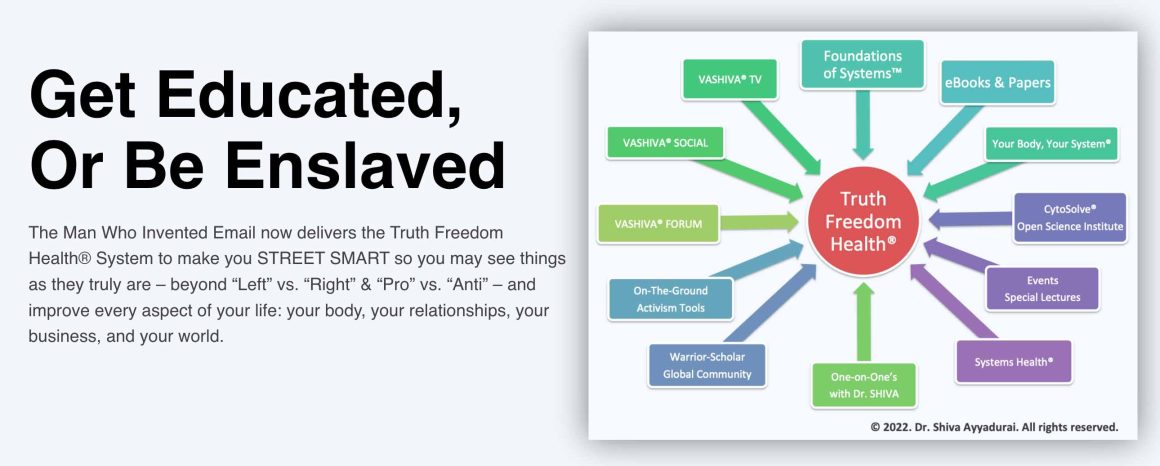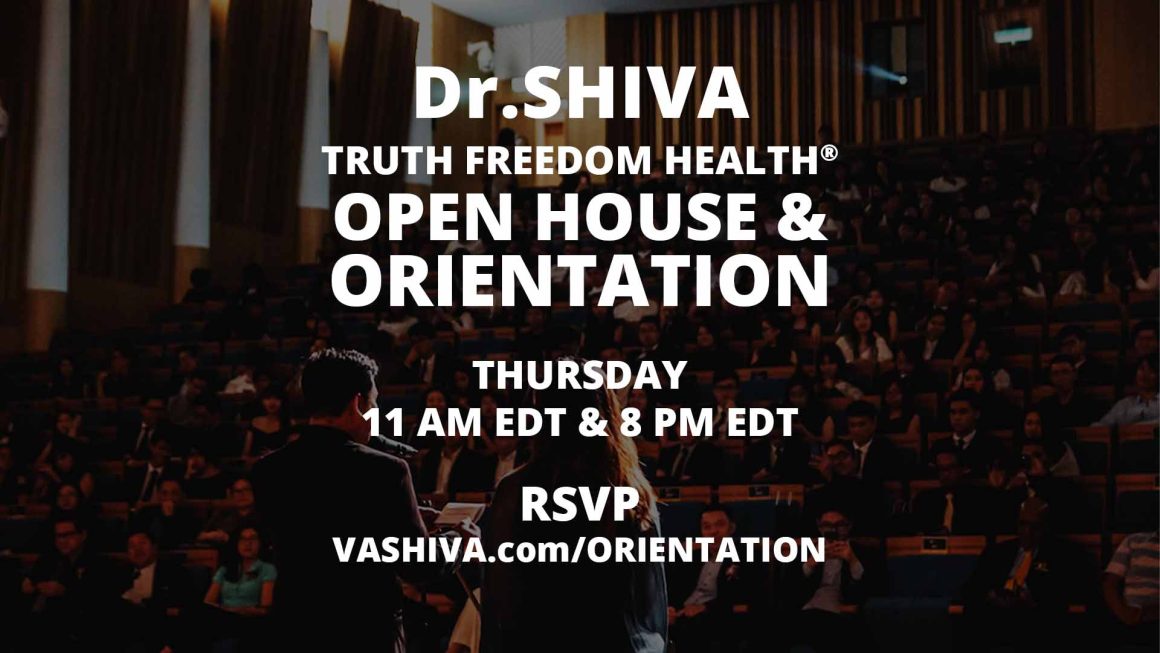In this discussion, Dr.SHIVA Ayyadurai, MIT PhD, Scientist & Engineer, Independent Candidate for U.S. President, reveals how insurance companies, GPOs, and Hospital administrators have colluded to creating artificial shortages and price gouging of important generic medicines, affecting the biology of millions of Americans.
Become a Truth Freedom Health® Warrior-Scholar

Attend Truth Freedom Health® Thursday Open House

ROUGH TRANSCRIPT (Auto-Generated)
Good evening, everyone. It’s Dr. Shiva Ayyadurai.
As I promised you yesterday, as are part of our policy to biology series, I’m going to be doing a deeper dive to share with you why there are medical medicine shortages, and all sorts of supply shortages in US hospitals. As I shared yesterday, these shortages have, it’s not something new. It’s been going on for decades, in fact, and what we discussed yesterday was we gave you sort of the overview of why this is occurring, because of the collusion that takes place between insurance companies and GPIOs.
And group purchasing organizations, which we’re going to talk about, or pharmacy manager brokers, which occurs on the pharmacy level. But I promised you that I’d walk you through step by step, how these collusions took place. So you get a deeper understanding of why health care costs are high.
As I discussed yesterday, the reality is, it’s not that insurance companies randomly charged their costs, or their charges to you and why insurance costs are high. The reason insurance costs are high, you’re going to realize is because the insurance companies over the last 50 years have built a very close collusion with organizations called group purchasing organizations. And on the other side called GPOs, or pharmacy manager brokers PBM.
Okay, sorry, pharmacy broker managers. And, and we’re going to focus today on the GPOs, because the same idea follows through on the pharmacies. And I’m going to walk you through using the whiteboard here.
And analysis. So let’s begin, first of all, by looking at different hospitals. So if we look at a hospital here, and let’s assume there’s different hospitals, you know, there were hospitals, which were independent hospitals, at one time, they weren’t part of large conglomerates.
So let’s say you had a hospital here. And it’s going to use this to denote a hospital and say h one, hospital one. And let’s say there’s another hospital here.
And let’s call this H two. And then there’s another hospital here, h three, okay? So there’s three different hospitals that you can have go all the way to h n, okay, and different hospitals. So these hospitals need supplies.
So let’s walk over here. And let’s put this little cloud here of different supplies. So hospitals need to buy supplies, right? And this supplies could include things like insulin, right? If someone’s rushed to a hospital, they need insulin, it could involve cancer drugs, right? People in late stage cancer, they didn’t take care of their bodies or whatever happened.
They have cancer drugs, it could be sailing, right? You know, bags of sailing all the way down to you know, things like catheters, right? Everything you see in a hospital has to be bought from different suppliers. And there’s various companies who have the supplies. So let’s say hospital one, and there’s an administrator here, and they have to buy insulin.
All right. So they will negotiate a price with the insulin company, maybe they need 100 Insulin bags, and they’ll say, and they’ll negotiate a price at $10 per bag of insulin, okay? And they’ll have to do this individually, another hospital would also go to the supplier, and they say, Look, I’m going to pay you and then negotiate a price of $2 a bag, okay? Because they’re, maybe they’re gonna buy, you know, 200 units, and then another hospital will go to the same insulin company, maybe they’re gonna buy 10,000 units, and maybe they negotiate a price of $5 back. Okay.
So what you see here is, each of these hospitals have negotiated individual crisis with these insulin companies. So what ended up happening as this was occurring around in the 70s these hospitals said why don’t we get together and, and buy together bags of or in this case? Insulin bags directly from the supplier together. So in order to do that, what these hospitals did was they brought in a broker, and the broker was called a GPO.
Okay? So what was the GPO GPO was a group purchasing. Organization was like an agent. Okay? And this agent GPO for short.
And what these hospitals would do is they would go to this agent and they say, Hey, look, we need 100 bags, hospital one. Hospital two said we need 200 bags. And hospital three said you know we need whatever, let’s say 300 bags, okay? So the total this guy, the GPO was going to purchase from this person was 500 bags of insulin, okay? And return the insulin price was set at let’s say, you know, $8 a bag.
Okay? So these guys each had to essentially pay $8 A bag for that insulin $8 A bag $8 A bag and $8 a bag. Okay, so this is a pretty good deal, right? Because before this guy was paying a lot more, so they pooled their needs to this supplier. So bottom line, the GPO served as their middleman going and he did this across the board for was cancer drugs or saline, or catheters, okay? So this GPO became the single agent getting whatever supplies the hospitals needed, from suppliers.
Now, the suppliers over here could be, you know, drug companies, big pharma could be over here or small pharma company, right? It could be you know, manufacturer X, manufacturer y or manufacturer Z. These are all different companies who make this. And the GPO was signed agreements with these people, long term agreements, short term agreements, and these were contracts, right? So these contracts were signed.
And the GPO actually owned the relationships over time with these people. So think about what I’m saying. As GPOs grew between, you know, this period over the last 30 years, initially, they were servicing the hospitals here, right? They were helping the hospitals get a lower rate.
But now think about what happened over time over time. The GPO is controlling the supply of nearly every item, bedpans pillowcases, sheets, drugs. You know, ventilators everything you can imagine, is coming from the suppliers into the hospitals.
In fact, the GPO could build if there was a supplier here, and there can be let’s say, z one, z two, so on Z five suppliers who all do insulin, and the GPO could do preferential deals, maybe with Z five, not only was he going to give him a better deal, but maybe the guy was going to take him on a vacation, right? All sorts of backroom deals started occurring. And after a certain point, around 2000, period, so this this start in the 1980s, around 2000s. These GPOs sort of flipped the game.
They went to the hospitals, and they said, Look, we’re getting you great prices, do you really need to get such discounts? And what ended up happening was the GPIOs started dictating price and supply to the hospitals. So they would tell the hospitals look, I can get you this bag of insulin, not for eight bucks. But how about you pay? You know, 10 bucks, you’re still better off? Or nine bucks, right? So they started dictating price because they controlled all of these relationships.
So the GPIOs would tell the hospitals what to do. In fact, in every hospital is a person who’s running the hospital, the president of the hospital, right? President one right person here, person here, right? These people the GPO would give kickbacks to the President for accepting the price that they were saying this could be, you know, hold special hotels, vacations. Okay, so literally the GPL was buying the hospital administrators, essentially corruption.
So they would accept the price that they were giving. It was a little bit less than what they would pay, obviously, if they had to do it individually, but it wasn’t the great pricing that they were getting before. But fundamentally, the GPO could control supply and if you remember basic macro economics, He who controls supply control is price.
Okay? Now how does this fit into the high cost of health care? As I mentioned, as you look at this, the key thing relevant to today’s topic, as you can see, the GPIOs are controlling supply from multiple suppliers into hospitals. Today, there are only three major GPOs three, remember that number three major GPOs. And what has occurred over the last three to four years, and I talked about this back in 2016, to 2020 2017, six years ago, is that these three GPIOs have connected with the three major insurance companies.
So the three main connected meaning that three major insurance companies have now bought a put it like this. The three insurance companies, okay, the three GPIOs now own the three GPOs. What does that mean? Let’s think about that.
Now, what does that mean? So here we have the group purchasing organizations are essentially in a monopolistic way, controlling the flow of every supply that comes into every hospital. Think about what that means. You go into a hospital and everything, God forbid you go into hospital, no one should have to go there.
But if you do, everything that you see in that hospital, the pillowcases are bedpans, the insulin, the drugs, assailing the catheters, all of that are typically coming from one GPO into that hospital. All right. Now, what is the interconnection between a GPO and an insurance company? Let’s think about this.
So an insurance company. And if you’re the individual here, you’re the patient here. The insurance company, what’s your relationship? You pay the insurance company, some dollar per month? This is called your premium.
Okay? Some people you know, I’m paying like 800 bucks a month. Okay. All right.
So your your your insurance to the insurance company is 800 bucks a month? All right, let’s say that’s what it is in 2023. In 2024, they may want to raise this to 900 bucks a month, right? Now, when they do that, how are they able to justify that? Why is it we keep paying insurance? Because the insurance companies have to work on what’s called fear, uncertainty and doubt. Why do you buy insurance? It’s the IBM selling model, oh my god, something could happen.
Oh, my God, the price could be so high. And this is key. The insurance companies profit and scare you into justifying their higher premium by telling you, you know me, John, a bob, the price could be very high tomorrow, you know, for if you God forbid, get into a hospital, oh my god, you know, the price of the cancer drugs, the price of the insulin, the price of the saline, these things are going up.
If you don’t have insurance, you’re gonna have to pay for this out of pocket and you go, Oh, my God, let me pay. I’m willing to pay you 900 bucks a month next year. In order to do this insurance companies, three of the major insurance companies now bought three of the major GPIOs.
What does that mean? That means there, they can go to the GPIOs. And there’s a nudge nudge wink wink their own part of their companies because insurance companies and GPOs emerge. The GPIOs now are incentivized to keep the price high because that’s how they make more profit.
If they go to a hospital and say, well, the insulin bag is 50 bucks. The guy says, Oh, wow, it’s 50 bucks, right? He’s getting a kickback, the GPOs are getting a percentage of that sale. That’s how they make money.
GPOs are making a piece of this sale. So they’re controlling the supply. The GPO is also an incentivized to go to a hospital administrator and say, hey, look, the price is now 90 bucks.
And you know, the supplies is going to be really tight. So the hospital administrator pays the GPO more money. So the game between the GPOs and the hospital administrators keeps the price high.
The high price of all of these supplies is what the insurance companies used to make you say, oh my god, I’m unwilling to pay higher for the for the premium and God forbid I go to a hospital the price is going to be so high. So what is really happening here is when you go into one of these hospitals, right? The visit to that hospital is high, as I talked about yesterday, because everything coming into that hospital is high. Everything coming into that hospital is high because of the GPIOs And the insurance linkage.
So the GPIOs and the three major, sorry, the insurance coverage, the three major GPIOs are in a tight bond, where the goal is to get jacked up price. And when you jacked up price, you can charge more for the insurance premium. Okay? Because the more the prices of the hospital supplies, right? And how do you get price high? Well, you need shortages, you need to more shortages.
You get more increase in price. That’s basic macro economics. So I hope this helps you understand that there was a time, you know, as we go back here that hospitals would buy direct, right.
And this was a model that hospitals were doing is very inefficient, prices were high, but they could control their own destiny. And now when they brought these middlemen in, as we go here, when hospital precedents, the bean counters, did these relationships with the GPIOs. It worked well initially.
But the GPOs flipped it as I talked about, they started controlling, dictating, they started dictating to the hospitals what to do, the presidents were paid off through these kickbacks. And the entire process was flipped on its head. And a few set of people few GPOs, there’s a monopoly control the entire supply, as well as a price into hospitals, high price, insurance companies can demand more premium.
Now tomorrow, we’re going to talk about as President Xi refer president, what I will do to bust all this up to give you a couple of hints, obviously, this link is a problem insurance companies and GPOs and this cahoots. That’s, that’s a serious problem. And the other big problem you can see here is that the entire relationship between these hospital presidents, and the kickbacks that they get is also problematic.
But that’s what we’ll talk about tomorrow. But in closing, the main thing you should leave away with is that group purchasing organizations are controlling the supply of everything from suppliers into hospitals, there’s an incentive here for them to create shortages. And with those shortages, they can decide which suppliers they want to work with.
Because on the back end, the suppliers are doing back and deals with GPOs. And by the way, no one can get access to these contracts that they have. So a couple of days ago, the FDA allowed unapproved cancer drugs coming from China.
So China’s also over here to supply cancer drugs through GPOs to a hospital. Now, why was this who created the shortage of us cancer drugs, so they’re US manufacturers here. They’re not able to, for some reason, given us cancer drugs.
And so the the GPOs went to Chinese companies, and they got the FDA to bring that in because of this urgency. Oh my god, we don’t have enough cancer drugs. So the level of corruption that’s going on the back end, and the opacity of it, which means there’s very little transparency is what’s allowing all these shenanigans to take place.
But anyway, tomorrow, we’ll finish our series on why are there medicine shortages in the United States by looking at how we break this up, and that’ll give you details on life policy, for health care for really reducing costs to increase quality. Thank you, everyone. Thank Thank you, everyone.
I hope this helped. Thank you.


